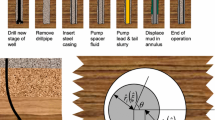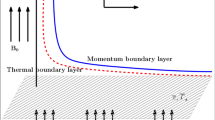Abstract
This paper investigates the possibility of kinematic interfacial instabilities occurring during the industrial process of primary cementing of oil and gas wells. This process involves flows in narrow eccentric annuli that are modelled via a Hele-Shaw approach. The fluids present in primary cementing are strongly non-Newtonian, usually exhibiting shear-thinning behaviour and often with a yield stress. The study is a sequel to Moyers-González and Frigaard (J Eng Math, DOI 10.1007/s10665-007-9178-y, 2007), in which the base analysis has been developed for the case of two Newtonian fluids. The occurrence of static mud channels in primary cementing has been known of since the 1960s, (see McLean et al. 1966; SPE 1488), and is a major cause of process failure. This phenomenon is quantified, which provides a simple semi-analytic expression for the maximal volume of residual fluid left behind in the annulus, f static, and illustrate the dependency of f static on its five dimensionless parameters. It is shown that three of the four different types of static channel flows are linearly stable. Via dimensional analysis, it is shown that the base flows depend on a minimal set of eight dimensionless parameters and the stability problem depends on an additional two dimensionless parameters. This large dimensional parameter space precludes use of the full numerical solution to the stability problem as a predictive tool or for studying the various stability regimes. Instead a semi-analytical approach has been developed based on solution of the long-wavelength limit. This prediction of instability can be evaluated via simple quadrature from the base flow and is suitable for use in process optimisation.
Similar content being viewed by others
References
Economides MJ (1990) Implications of cementing on well performance. In: Nelson EB (eds) Well cementing. Schlumberger Educational Services, Houston
Primary and Remedial Cementing Guidelines. Drilling and Completions Committee, Alberta, April 1995. Distributed by the Petroleum Industry Training Service
Nelson EB (eds) (2001) Well cementing. Schlumberger Educational Services, Houston
McLean RH, Manry CW, Whitaker WW (1966) Displacement mechanics in primary cementing. Society of Petroleum Engineers paper number SPE 1488
Guillot D, Hendriks H, Callet F, Vidick B (1990) Mud removal. In: Nelson EB (eds) Well cementing. Schlumberger Educational Services, Houston
Lockyear CF, Ryan DF, Gunningham MM (1989) Cement channelling: how to predict and Prevent. Society of Petroleum Engineers paper number SPE 19865
Pelipenko S, Frigaard IA (2004) Visco-plastic fluid displacements in near-vertical narrow eccentric annuli: prediction of travelling wave solutions and interfacial instability. J Fluid Mech 520: 343–377
Bittleston SH, Ferguson J, Frigaard IA (2002) Mud removal and cement placement during primary cementing of an oil well; laminar non-Newtonian displacements in an eccentric annular Hele-Shaw cell. J Eng Math 43: 229–253
Pelipenko S, Frigaard IA (2004) On steady state displacements in primary cementing of an oil well. J Eng Math 46(1): 1–26
Pelipenko S, Frigaard IA (2004) Two-dimensional computational simulation of eccentric annular cementing displacements. IMA J Appl Math 64(6): 557–583
Tehrani A, Ferguson J, Bittleston SH (1992) Laminar displacement in annuli: a combined experimental and theoretical study. Society of Petroleum Engineers paper number SPE 24569
Tehrani A, Bittleston SH, Long PJG (1993) Flow instabilities during annular displacement of one non-Newtonian fluid by another. Exp Fluids 14: 246–256
Moyers-González MA (2006) Transient effects in oilfield cementing flows. Ph.D. dissertation, University of British Columbia
Moyers-González MA, Frigaard IA, Scherzer O, Tsai TP (2007) Transient effects in oilfield cementing flows: qualitative behaviour. Euro J Appl Math 18: 477–512
Moyers-González MA, Frigaard IA (2007) Kinematic instabilities in two-layer eccentric annular flows, part 1: Newtonian fluids. J Eng Math doi:10.1007/s10665-007-9178-y
Schmid PJ, Henningson DS (2001) Stability and transition in shear flows. Springer-Verlag, New York
Frigaard IA, Howison SD, Sobey IJ (1994) On the stability of Poiseuille flow of a Bingham Fluid. J Fluid Mech 263: 133–150
Author information
Authors and Affiliations
Corresponding author
Rights and permissions
About this article
Cite this article
Moyers-Gonzalez, M.A., Frigaard, I.A. Kinematic instabilities in two-layer eccentric annular flows, part 2: shear-thinning and yield-stress effects. J Eng Math 65, 25–52 (2009). https://doi.org/10.1007/s10665-008-9260-0
Received:
Accepted:
Published:
Issue Date:
DOI: https://doi.org/10.1007/s10665-008-9260-0




